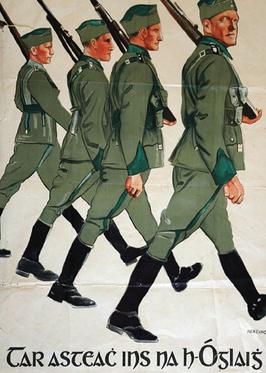These murders started just before the sudden deaths of Collins and Griffith - Collins killed in a gunfight on August 22, 1922 in his native Cork, Griffith of a heart attack 10 days before, and continued until after the end of the Civil War.
The epicentre was their Criminal Investigation Department, the sinister group based at Oriel House on the corner of Fenian Street and Westland Row, which assassinated a series of anti-Treaty republicans in 1922.
Kevin O'Higgins, the Minister of Home Affairs, a nephew of Parnell's sidekick and betrayer Tim Healy, had unleashed them with the cool statement "what was needed to put down the 'Irregulars', were more local executions, and we should just kill them anyway". The 'Irregulars' was what the Free State government called the anti-Treaty republicans, carefully moulding the language.
The CID began with the killing of Harry Boland on August 1 1922; a week before his death he'd said "I know too much about Mick [Collins]; he won't let me live."
Three days after Collins' August 8 1922 death two Fianna boys were picked up at Newcomen Bridge - the bridge where James Joyce sets the beginning of his paedophile story An Encounter, in Dubliners. They were shot dead in front of witnesses in Whitehall, near what's now Dublin City University, in what was assumed to be a reprisal for Colllins' killing. The killings continued, at the rate of one or two a week.
One of these long-forgotten dead was 17-year-old Edwin Hughes, who, on October 7 1922 was picked up by the secret police based at Oriel House, along with two friends, Brendan Holohan, also 17, and 16-year-old Joseph Rogers.
Edwin had grown up in a respectable civil service household headed by his father Mark, a temporary clerk in the Public Record Office, and his old uncle Martin, a former assistant clerk in the Education Office.
In the 1911 census there were four boys in the house: Edwin, then six, and his brother Gerald, eight, and his cousins Martin and William, aged 16 and 18.
His friend Brendan Holohan was the son of a telegraphist in the GPO, and was one of a stepfamily of six children.
The third lad, Joe Rogers, was the youngest of a commission agent's long-tailed family of five children - his eldest brother was 26 years older than him. A 'commission agent' was a bookie; his father was the popular Dublin bookmaker Thomas Rogers; Joe was already a promising apprentice mechanical engineer.
A pal of the boys, Jennie O'Toole (probably the child who appears in that 1911 census as Mary Josephine O'Toole, daughter of a railway auditor living in nearby Richmond Road), was pasting up republican posters and received some abuse from another neighbour. This shouter was Captain Pat Moynihan of the Irish (Free State) Army, who lived on Clonliffe Road, and whose home had been one of Michael Collins' main typing depots. As a postal worker, Moynihan had been Collins' inside man fingering mail deliveries that could be raided. Now he was the senior officer in Oriel House…
To free Jennie from being shouted at, the three boys took on the postering with her, and were arrested. They were taken into a lorry at Clonliffe Road in Drumcondra by Charlie Dalton and Nicholas Tobin, G-men from Oriel House and also from this same neighbourhood.
Charlie Dalton was just 19. He lived a coupe of streets away from his victims, in St Columba's Avenue. Son of an American father (now the manager of a laundry) and an Irish mother, he was second of a family of five. His brother was Major-General Emmet Dalton, now aged 24, head of intelligence for the Free State, who had been at the side of his adored friend Michael Collins six weeks before when he died in a republican ambush on August 22.
Nicholas Tobin wasn't much older; he was 23, son of a hardware clerk from Cork; the 1911 census has the family in Kilkenny - the parents plus William (soon gaelicised to Liam) Tobin, who would be Collins' chief profiler of assassination targets during the War of Independence, and Nicholas, and their sister Katherine, along with two boarders, a literature teacher and a cycle mechanic; life is full of interest and variety.
The CID men Emmet and Charlie Dalton, Nicholas Tobin and Pat Moynihan had all been members of Michael Collins' 'Squad' – the group of assassins who carried out the targeted killings of British agents in Ireland, most famously wiping out the British intelligence network known as the Cairo Gang, who had been sent to kill the Irish leaders, on November 21, 1920 (an account from the British parliament's record, Hansard, quotes Charlie Dalton's own book on the events of that night http://hansard.millbanksystems.com/lords/1931/may/06/with-the-dublin-brigade-1917-1921).
Now, however, Charlie and Nicholas were on a different job: the killing of those who opposed the new government, including children.
The three teenager leafletters left the Hughes house in Clonliffe Road at 10.30pm on October 7, 1922. They were seen in Charlie Dalton's military lorry a little later; this was the last time they were seen alive. Their bodies were dumped near the Naas Road, where the Red Cow roundabout on the M50 is now, and were found the next day. Soon, Nicholas Tobin would be dead too, shot by his Oriel House colleagues as they attacked a bomb factory in Gardiner Street.
At the boys' inquest, Dr Frederick Ryan, who performed the post mortem, described the wounds that killed them.
"Joseph Rogers' overcoat was saturated with blood," he said. "He had 16 wounds altogether. There was an entrance wound in the back of the skull, about an inch and a half from the ear. There was no exit wound. It was possible for a man to inflict this wound while both were standing. There was no singeing. In the left upper jaw there was an entrance wound, but no corresponding exit wound. There were superficial wounds on the left side of the body corresponding to the nipple, on the left side of the abdomen, a punctured wound on the left side of the nose, an entrance and exit wound at the base of the left index finger, superficial wounds on the left arm, an entrance and exit wound in the middle of the left thigh, a large contused wound on the left shin bone, and an incised wound on the left knee, probably caused after death." In his opinion, the wound at the back of the skull would be sufficient to cause death; so would those through the right jaw or in the nose. There was no singeing in the head. His body had been identified by his brother Michael.
Brendan Holohan's father identified his body. The doctor reported that "Regarding Brendan Holohan there was a bullet hole through the peak of his cap, but no mark on his head. The coat was torn on the right elbow, and there was a wound through the flesh of the arm, corresponding with the perforation in the sleeve. There were two entrance wounds, four inches from each other, in the right chest, but he did not find any exits. They were clean cut, such as might be made by an instrument of the same diameter as a pencil. The clothing was perforated at the place corresponding with these wounds. There was a wound over the right shoulder blade, which was an old one. There was an entrance wound in the lower portion of the abdomen, and he found a bullet lodged in the surface over the left hip bone and the shin. There was a wound in the back of the skull in the occipital protuberance, which took a downward direction into the neck and severed the spinal cord. This was sufficient to cause death immediately. If a man was standing on top of a ditch he could have been shot in the head, otherwise he must have been lying down."
In the case of Edwin, he said, "The first wound, on the right-hand side corresponding to the second rib, took a horizontal direction and pierced the great vessels of the heart. There was no exit wound to it. There was no singeing. Another bullet pierced the overcoat on the right side, but there was no mark on the inner coat or vest. There were wounds in the abdomen and on the left thigh. On the right knee and right arm there were superficial wounds, such as might be caused by grazing bullets. The clothes were cut as if by barbed wire. The abdomen wound might possibly be caused by a prod of some instrument, but that was not probable." In his opinion, the wound to the chest caused death.
Edwin's body had been identified by his elder brother, Gerald.
A particularly tragic aspect to the killing comes from the Waterford Quaker diarist Rosamond Jacob, who wrote on January 25 1923:
"[Mrs Kiernan] told us about Edwin Hughes & his brother too. He had an elder brother Gerald, who was offered a good job at Oriel House some time ago (he had been in the IRA & was still republican, but was engaged to a girl who said she wd have nothing to do with him if he didn't take this job). Against the wish of his mother & brother he took it, for the sake of the girl – not liking it at all himself. The night Edwin was arrested, Gerald passed by the lorry as it was standing still, & saw Edwin in it, in a navy light overcoat. He scarcely believed it was Edwin till he went home & found E not there, and learned from his mother that he had gone out in that overcoat. Then came the news of E's murder, & the investigation at the inquest. Gerald gave up the job at Oriel House, and seemed to lose all interest in life – thought of nothing but Edwin & his own late association with the CJD [Criminal Justice Department] - and in 3 weeks died of a broken heart – no illness apparent at all."









